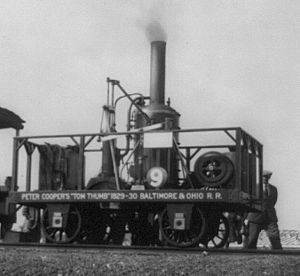Tom Thumb
| Tom Thumb | |
|---|---|
|
Replica of the Tom Thumb from 1927
|
|
| Number: | 1 |
| Manufacturer: | Canton Iron Works near Baltimore |
| Year of construction (s): | 1830 |
| Retirement: | 1830 |
| Axis formula : | 1A |
| Length: | 4 m (free replica) |
| Height: | 3.9 m (free replica) |
| Top speed: | loaded: 29 km / h |
| Particularities: | Firing by anthracite coal |
| scrapped, in the 20th century a free replica was made | |
As an experimental machine , the Tom Thumb was the first American-made steam locomotive . It was the result of first attempts with imported English locomotives , which often did not correspond to the curve radii required in the USA . The locomotive was fired with anthracite coal.
On December 28, 1827 the foundation stone for the Baltimore and Ohio Railroad (BO, B&O) was laid. As is often the case all over the world, the passenger and freight cars were pulled by horses . It had been recognized that rail vehicles enabled faster, safer, smoother and more pleasant travel for passengers , but those responsible did not yet trust the slowly emerging steam locomotives. In addition, the first attempts with locomotives imported from England had failed because they were too heavy for the tracks of the lighter horse railways . It was also not possible with the imported machines to drive the tight curve radii that the horse-drawn carts were possible. A new construction of the line was ruled out and so it stayed with the old one for the time being.
The autodidact of railway technology, Peter Cooper , prevailed in America with his ideas that the future of transport would be determined by the railways . He investigated the difficulties with the English import locomotives and the Baltimore & Ohio railroad. His result was a smaller and lighter locomotive, which was manufactured in his Canton ironworks near Baltimore. It was not until years later that received vehicle named Tom Thumb (for an English version of the tale of Tom Thumb ).
On May 24, 1830, the regular horse-drawn tram operation began on the rail line from Baltimore to Ellicotts Mills , now Ellicotts City / Maryland , which was just completed by Baltimore & Ohio . This route stretched around 21 kilometers through the country. It was a fitting opportunity for Cooper to publicly demonstrate the superior performance of his machine over horses.
The improvised race
A steam ride on the two parallel tracks of the horse-drawn tram to Ellicotts Mills was prepared. August 28, 1830 was set as the date by the railway company. John Hazlehurst Boneval Latrobe, author, inventor and lawyer of B&O, was there with around 40 passengers in an open car that was attached to the locomotive. Cooper personally controlled his experimental machine. Among other things, John Latrobe reported:
“The most remarkable thing was the journey itself. Turns were taken without difficulty at a speed of fifteen miles per hour [around 15 miles per hour]; Climbed heights with comparable ease. It was a successful day: the tour company was ecstatic and some excited gentlemen in the party were writing their names and a few connected sentences in log books at a top speed of eighteen miles an hour to check whether it was would be possible to do this at such a high speed. The drive back from the mills - a distance of thirteen miles [around 21 kilometers] - took fifty-seven minutes. "
On the way, the horse-drawn carriage driver challenged Peter Cooper with his machine to a race, which was accepted. The Tom Thumb pulled past the horse with ease until the driver finally won the race due to technical difficulties. Even so, that day had convinced the senior management of Baltimore & Ohio that the locomotive had a much higher performance potential than the horse. Therefore, the decision-makers decided to break the gap to the steam train for economic reasons. In a short time it became possible for society to assert itself against opponents.
All Baltimore & Ohio horses were retired on July 31, 1831 and replaced by steam locomotives.
End and replica
Shortly after rail operations began in 1835, B&O in Baltimore issued its earliest shares. Among other things, there was a fine illustration of the Tom Thumb, which had established the fame of this company.
Since the Tom Thumb was not built as an experimental locomotive for service, the race ended its short, successful career. It was not preserved for posterity. In 1892 a wooden model of this locomotive was made. From this model, in turn, the 1: 1 replica, which is now in the Baltimore and Ohio Railroad Museum , was created in 1926 for a railroad exhibition, but which differs significantly from the original in many important points.
literature
- John Hazlehurst Boneval Latrobe : The Baltimore and Ohio Railroad: Personal Recollections A lecture, delivered before the Maryland Institute. Sun Printing Establishment, Baltimore 1868
- First American Steam Railroad (1830) by John Hazlehurst Boneval Latrobe (1868) Race between Cooper's steam engine and a horse in: Albert Bushnell Hart (Ed.): American History Told by Contemporaries Volume 3, 1927
- Chapter XX The First Experimental Locomotive - Peter Cooper in William H. Brown:
The history of the first locomotives in America: from the original documents, and the testimony of living witnesses. Revised edition Publisher: D. Appleton and Company, New York 1874
Web links
- Collections - Tom Thumb at the B&O Railroad Museum, Baltimore

